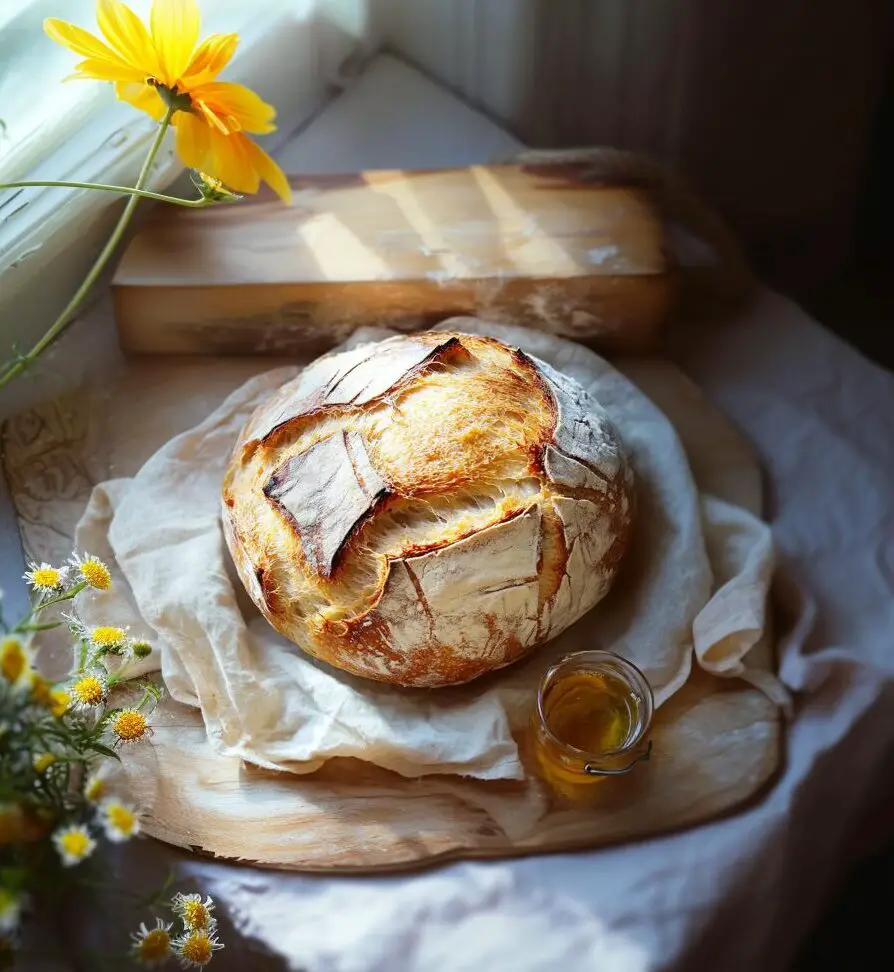This beginner-friendly sourdough bread recipe simplifies the art of sourdough baking. Requiring minimal hands-on time and no complex techniques like autolyse or preferments, it’s perfect for those new to sourdough. The result is a crusty, golden loaf with a light, airy crumb that rivals any bakery offering.
Full Recipe:
Ingredients
- 50–100 g (¼–½ cup) bubbly, active sourdough starter (100 g recommended)
- 375 g (1½ cups plus 1 tbsp) warm water
- 500 g (4 cups plus 2 tbsp) bread flour
- 9–12 g (1½–2½ tsp) fine sea salt
Directions
- Mix the Dough: In a large bowl, whisk together the sourdough starter and warm water. Add the bread flour and salt, mixing until a rough dough forms. Cover with a damp towel and let rest for 30 minutes.
- Stretch and Fold: After resting, perform a series of stretch and folds by pulling the dough from the edge and folding it into the center. Repeat 4–5 times around the dough. Let it rest for 30 minutes and repeat the process. Aim for 4 sets over 2 hours, but even one set is beneficial.
- Bulk Fermentation: Cover the bowl and let the dough rise at room temperature (about 70°F or 21°C) for 8–10 hours, or until it has increased by approximately 50% in volume and shows bubbles on the surface.
- Shape the Dough: Gently turn the dough onto a lightly floured surface. Shape it into a round by folding the edges into the center, rotating the dough as you go. Use a bench scraper to create surface tension.
- Bench Rest: Let the shaped dough rest, seam side up, for 30 minutes. Meanwhile, line an 8-inch (20-cm) bowl or proofing basket with a flour sack towel and dust it with rice flour.
- Final Shaping and Proofing: Reshape the dough as before and place it seam side up into the prepared bowl. Cover and refrigerate for at least 1 hour or up to 48 hours.
- Bake: Preheat your oven to 500°F (260°C) with a Dutch oven inside. When ready to bake, carefully invert the dough onto parchment paper, score the top, and transfer it into the hot Dutch oven. Cover and bake for 20 minutes, then uncover and bake for an additional 25 minutes, or until the crust is deep golden brown.
Nutritional Facts (Per Slice, Based on 12 Slices)
- Calories: Approximately 150 kcal
- Carbohydrates: 30 g
- Protein: 5 g
- Fat: 0.5 g
- Fiber: 1 g
- Sodium: 200–300 mg (depending on salt quantity used)
What is Sourdough Bread?
Sourdough bread is made through the natural fermentation of dough using wild yeast and lactobacilli, a type of bacteria. The fermentation process is what gives sourdough its distinct tangy flavor. Unlike bread made with commercial yeast, which rises quickly, sourdough takes longer to ferment, often requiring overnight proofing or longer, depending on the method used. This extended fermentation time allows the flavors to develop, resulting in a loaf with deep, complex taste notes.
The key difference between sourdough and other bread types lies in the leavening agents. Commercial yeast is a single strain of yeast that is cultivated to grow rapidly, while sourdough uses wild yeast, which is naturally found in the environment. The symbiotic relationship between the yeast and the lactic acid bacteria present in the starter culture is what causes the dough to rise and develop its unique flavor.
The History of Sourdough Bread
Sourdough bread’s origins trace back over 5,000 years to ancient civilizations. Evidence suggests that the Egyptians were among the first to discover the process of fermentation for leavening bread, accidentally allowing wild yeast to ferment their dough. From there, the art of sourdough spread through Europe and beyond, becoming a staple in bakeries worldwide.
In the United States, sourdough became especially popular in San Francisco during the 19th century, when gold miners and pioneers discovered the area’s unique wild yeast strains, which gave the bread its characteristic tang. San Francisco’s sourdough is now famous worldwide and remains a symbol of American baking culture.
Why Bake Sourdough?
There are many reasons to try baking sourdough bread, even for beginners. First and foremost, making sourdough from scratch is an incredibly rewarding experience. The process of creating a starter, nurturing it, and watching the dough rise through natural fermentation is a deeply satisfying and hands-on activity. The patience required for sourdough baking also offers an opportunity to connect with the centuries-old tradition of artisanal bread making.
Secondly, sourdough bread is known for its health benefits. Due to the long fermentation process, sourdough bread contains lower levels of gluten, making it easier for some individuals with gluten sensitivity to digest. The fermentation process also reduces the presence of phytic acid, which can interfere with mineral absorption in the body. Additionally, the wild yeast and bacteria involved in the fermentation process are thought to have probiotic properties, contributing to gut health.
The Science Behind Sourdough
Sourdough bread-making is a delicate balance of science and art. At the heart of the process is the interaction between wild yeast and bacteria. Wild yeast, as opposed to the commercially produced yeast used in most bread, is much slower to rise but imparts a unique flavor due to the natural sugars it ferments. The bacteria that live alongside the yeast, typically lactic acid bacteria (LAB), thrive in the environment provided by the starter and help break down complex sugars in the flour.
The sour flavor of sourdough is primarily a result of the production of lactic acid and acetic acid by the bacteria. These acids develop as the bacteria consume the sugars present in the flour, contributing to the bread’s characteristic tang. This slow fermentation process not only develops flavor but also allows the bread’s crumb to become lighter and airier over time.
How to Make Sourdough Bread
Making sourdough bread requires a few basic ingredients: flour, water, salt, and a sourdough starter. The starter is a culture of wild yeast and bacteria that you cultivate from scratch. It can take several days to establish, requiring regular feedings with flour and water to keep the yeast active. Once your starter is ready, you can begin making your sourdough bread.
Troubleshooting Common Sourdough Issues
Even seasoned bakers can encounter challenges when making sourdough bread. Below are some common issues and solutions:
-
Dense, Heavy Bread: If your bread is too dense, the problem could be with your starter. Ensure it is active and bubbly before using it in your dough. Additionally, make sure you are giving your dough enough time to rise during both bulk fermentation and proofing.
-
Underdeveloped Flavor: If your sourdough lacks tang, you may need to extend the fermentation process. A longer fermentation time, either at room temperature or in the refrigerator, will allow more time for the wild yeast and bacteria to develop the bread’s flavor.
-
Cracked or Flat Loaf: If your loaf cracks too much or spreads out flat, it could be a sign of over-proofing or under-shaping. Be sure to shape your dough tightly to create surface tension and resist over-proofing by keeping an eye on your dough during its final rise.
Advanced Sourdough Techniques
As you become more confident in baking sourdough, there are several advanced techniques you can explore. For example, you can try using a combination of flours like whole wheat or rye to alter the flavor and texture of your loaf. Additionally, some bakers experiment with using different types of starter cultures, including those made with whole grains or even fruit.
Conclusion: The Joy of Sourdough Baking
Baking sourdough bread is more than just a culinary activity; it’s a rewarding and meditative process that connects you to centuries of tradition. Whether you’re a novice or an experienced baker, the journey of creating a perfect sourdough loaf is filled with both challenges and rewards. As you master the art of sourdough baking, you will not only develop a deeper understanding of the science behind bread-making but also create a delicious, homemade loaf that brings a sense of accomplishment.






